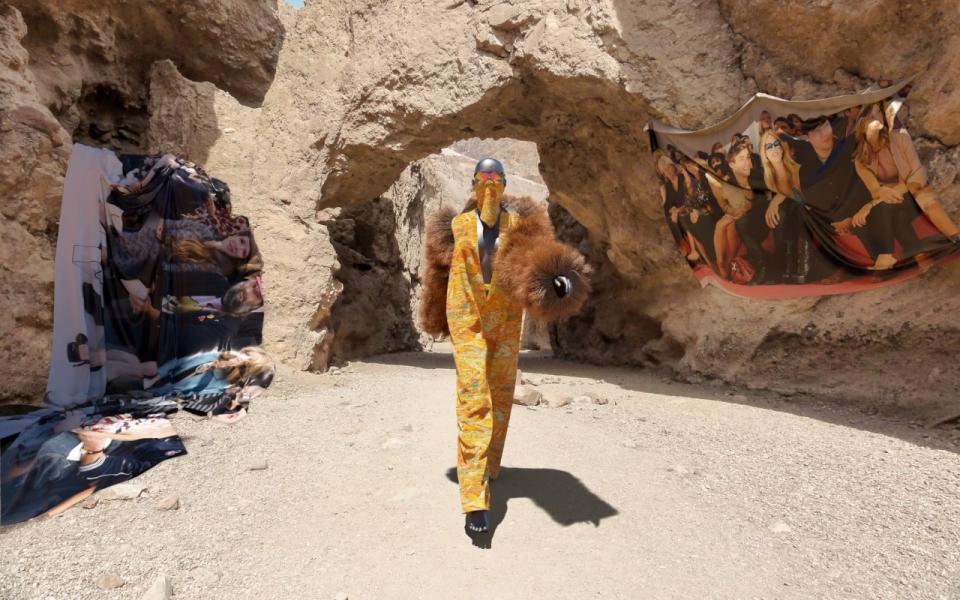The Digitalization of Fashion Explored in New Exhibition

A new museum exhibition in Helsinki explores universal themes that continue to take hold in fashion — 3D clothes, gender-neutral clothing, wearables and inclusivity.
Bowing Friday and running through March 13 in Helsinki’s Designmuseum, “Intimacy” highlights 40 Finnish designers and companies, and is indicative of how fashion around the globe is becoming more inclusive to people of various sizes, ages, genders, races and cultures.
More from WWD
One of the show’s curators, Annamari Vänskä, an Aalto University professor, said the “mediazation”(especially new media technology and social media) and the digitalization of fashion have made the discourse more mainstream and more important.” She said, “Ordinary people, who previously didn’t have access to the system of fashion, have become part of the discourse, debating online and posting about fashion. The fashion industry has been forced to change and participate in the wider fashion discourse — in terms of a wider cultural understanding of what fashion is and what is desirable in fashion. It’s about the public debate, and how fashion is defined and understood in culture.”
The exhibition touches upon such subjects as how social media usually inhibits people from seeing entire garments, and how virtual reality can make a garment just a digital thing, Vänskä said. As Instagram and other digital channels continue to become important means of fashion communication, some companies are taking a more digital approach. The Finnish Dutch company The Fabricant only makes 3D garments for avatars. The company collaborates with top fashion houses and also works as a creative agency specializing in digital fashion design.

Photo Courtesy of Helsinki Designmuseum
The “Intimacy” curator noted how fashion brands like Balenciaga are being immersed in the gaming industry, creating garments for the characters, and in some instances being able to buy the virtual clothes and dress your own avatar.
Venia Elonsalo’s clothing, which incorporate plush toys such as forms of tigers, elephants and giraffes, will be on view, as will The Fabricant’s digital-only fashion video with avatars and somewhat of a virtual catwalk, and Sasu Kauppi’s installation where he has used his designs as a screen on which he projects music that transforms into graphic elements. Kauppi has also worked as a designer for Kanye West’s Yeezy line.
Vänskä said, ”Fashion is often thought of as this frivolous and shallow part of culture. This exhibition shows the artistic and thoughtful processes that go into creating clothing. What I really want people to take home is that fashion is this field of culture where new ideas and political statements are being created. It’s not just about consuming, but creative thinking and making a statement about the state of the world in many cases.”
She added, “Fashion is this sphere where politics pertaining to bodies, gender, sexuality and race are conducted. It’s a critical, creative, political field.”

Photo Courtesy of Helsinki Designmuseum
The exhibition features styles by the 2020 “Young Designer of the Year” winner Ervin Latimer, whose clothes change based on the wearer’s body and size. Another designer, Henna Lampinen, aims to break fashion’s ultrathin ideal by using a more robust muse. Nomen Nescio’s all-black, genderless, graphically cut designs are on view. Wildkind Kids, Anna Isoniemi, Teemu Muurimäki, Aapo Nikkanen, Oura, Marimekko and Vyner Articles are among the other labels in the exhibition. A virtual tour will be available for two weeks, starting Monday on Designmuseo’s IG live at 11 a.m. EST.
The “Intimacy” exhibition is part of a larger research project that over the next three years should delve into the intricacies of creative work through fashion, digitalization and the education of cultures. The digitalization of fashion is “a welcome development,” especially in relation to thinking about how and what to produce, as well as for whom to produce, Vänskä said. Aside from the environmental benefits, creating fashion digitally frees up designers to experiment in the virtual world, she added.
However, with virtual being kind of immaterial, one element that needs to be developed is how will people be able to touch and feel as they can now with an actual garment, Vänskä said. “But there is quite a lot of research in incorporating touch and feeling in the virtual world. This is very important to incorporate because touching is so important, when it comes to fashion. It’s not just the aesthetics and the eye looking, but really experiencing. I am really confident that this will be taken into consideration much more in the future,” she said.
Sign up for WWD's Newsletter. For the latest news, follow us on Twitter, Facebook, and Instagram.

